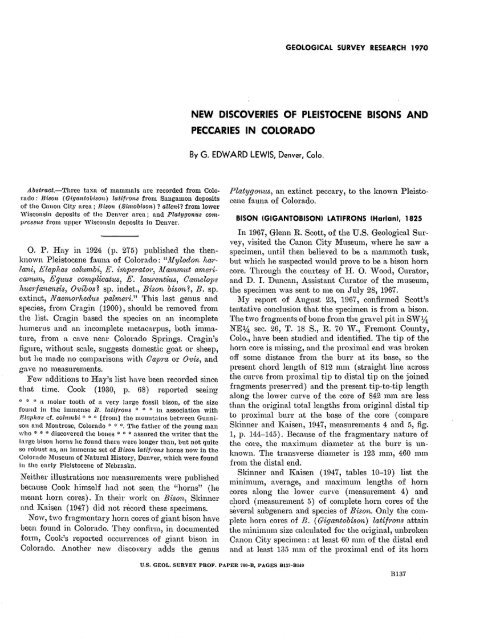RESEARCH· ·1970·
RESEARCH· ·1970·
RESEARCH· ·1970·
Create successful ePaper yourself
Turn your PDF publications into a flip-book with our unique Google optimized e-Paper software.
GE·OLOGICAL SURVEY RESEA-RCH 1970<br />
NEW DISCOVERIE'S OF PLEISTOCENE BISONS AND<br />
PECCARIES IN COLORADO<br />
By G. EDWARD LEWIS, Denver, Colo.<br />
Abstt·aot.-Thrcc taxa of mnnunnls nrc recorded from Colorado<br />
: JJ-ison ( G--igantob·ison) lat-lfrons from Snngnmon deposits<br />
of the Cnnon City nrcn; JJ·ison (S·itnobison)? alleni? from lower<br />
\Yisconsin deposits of the Denver area; and Platygon1ts oom,-<br />
1H'C881t8 from upper \Visconsin deposits in Denver.<br />
0. P. I-:Ia.y in 1924 (p. 2·75) published the thenknown<br />
Pleistocene fauna of Colorado: "Llfylodon haTlani,<br />
Ele1Jhas col~t'lnbi, E. in'bzJe'J·atm·, ill anLmlut ame'l·ican~tJ'In,<br />
l!:'quus co'lnJJUcat~ls, E. la~urenti~ts, Oanwlops<br />
h/tte7'fanensis, Ovibos ~ sp. indet., Bison bison~, B. sp.<br />
extinct, Naenwrhed~ts ]Jalme?·i." This last genus and<br />
species, from Crn,gin ( 1900), should be removed frmn<br />
the list. Cragin based the species on an incomplete<br />
humerus and an :incomplete metacarpus, both innnature,<br />
:from a cave near Colorado Springs. Cragin's<br />
Hgure, without scale, suggests domestic goat or sheep,<br />
but he made no comparisons with OazJra or Ovis, and<br />
gave no measurements.<br />
Few additions to I-Iay's list have been recorded since<br />
that time. Cook ( 1930, p. 68) repm~ted seeing<br />
(• ~~ ~~ a molur tooth of a very large fossil bison, of the size<br />
found in the immense B. lat-lj1·ons ·~ ~\ ~~ in association with<br />
1i.Jlcphas cf. colmnbi •:• ~~ ''' [from] the mountains between Gunnison<br />
nndl\Iontrosc, Colorado ~' ·~ ~\ The father of the young man<br />
who * "' ·~ discovered the !Jones '' ~~ "' assured the writer that the<br />
lnrge bison horns he found there were longer than, but not quite<br />
so robust ns, llll immense set of B·ison latifrons horns now in the<br />
Colorado Museum of Natural History, Denver, which were found<br />
in the early Pleistocene of Ncbrnslm.<br />
Neither illustrations nor n1easurements were published<br />
because Cook himself had not seen. the "horns" (he<br />
meant horn cores). In their work on Bison, Skinner<br />
and J(n.isen (1947) did not record these specimens.<br />
Now, two fragmentary horn cores of giant bison have<br />
been found in Colorado. They confirm, in documented<br />
form, Cook's reported occurrences of giant bison in<br />
Colorado. Another new discovery adds the genus<br />
Platygontts, an extinct peccary, to the known Pleistocene<br />
fauna of Colorado.<br />
BISON (GIGANTOBISON) LATIFRONS (Harlan), 1825<br />
In 1967, Glenn R. Scott, of the U.S. Geological Survey,<br />
visited the Canon City ~1useum, where he saw a<br />
specimen, until then believed to be a mamn1oth tusk,<br />
but which he suspected would prove to be a bison horn<br />
core. Through the courtesy of H. 0. 'V"ood, Curator,<br />
and D. I. Duncan, Assistant Curator of the n1useum,<br />
the specimen was sent to n1e on July 28, 1967.<br />
~1y report of August 23, 1967, confirmed Scott's<br />
ten:tati ve conclusion tJlutt tJhe specimen is frmn n, bison.<br />
11he two fragments of bone frmn tJhe gravel pit in S'¥1) 1<br />
NElJ.t sec. 26, T. 18 S., R. 70 ,¥., Fren1ont County,<br />
Colo., have been studied and identified. The tip of the<br />
horn core is missing, and the proximal end was broken<br />
off some distance frmn the burr at its base, so the<br />
present chord length of 812 n1m (straight line across<br />
the curve frmn proximal tip to distal tip on the joined<br />
fragments preserved) and the present tip-to-tip length<br />
along the lower curve of the core of 842 n1n1 are less<br />
than the original total lengths frmn original distal tip<br />
to proximal burr at the bm~e of the core (compare<br />
Skinner and I(aisen, 1947, measurmnents 4 and 5, fig.<br />
1, p. 144-145). Because of the fragmentary nature of<br />
the core, the maximmn diameter at the burr is unknown.<br />
The transverse diameter is 123 111m, 460 n1m<br />
frmn .the distal end.<br />
Skinner and ICaisen ( 1947, tables 10-19) list the<br />
minimum, average, and maximum lengths of horn<br />
cores along the lqwer curve (n1easurement 4) and<br />
chord (measurement 5) of complete horn cores of the<br />
sev:erail s.ubgenera and species of Bison. Only the complete<br />
horn cores of B. ( Gigantobison) latij'l·ons attain<br />
the minimum size calculated for the original, unbroken<br />
Canon City specimen: at least 60 mm of the distal end<br />
and at least 135 mm of the proximal end of its horn<br />
U.S. GEOL. SURVEY PROF. PAPER 700-B, PAGES Bl37-Bl40<br />
B137
















